
Even if you're not doing soul-crushing workouts on the daily, it's likely you feel cramped, sore, or stiff more often than not. Think about it: Most of us spend the majority of the day not using any muscles at all, sitting and slouching over a keyboard, which can wreak havoc on your hips, back, shoulders, neck, and more. And while there's no doubt exercise is amazing for your body, it can also lead to tight muscles and annoying aches. That's where these moves come into play.
Stretching is important as it lengthens your muscles, allowing you to use them to their fullest capability, explains Kristin McGee, a yoga and Pilates instructor in New York City. “It helps increase blood flow to our muscles, improves our physical performance, decreases risk of injuries, and enables our muscles to work effectively,” she says. Plus, stretching wakes us up, helps us breathe better, sleep better, and gives us better posture.
Feeling tight in all the wrong places? We tapped McGee and other fitness experts, including trainers and physical therapists, for the best stretches you can do for every part of your body. Let the healing begin!
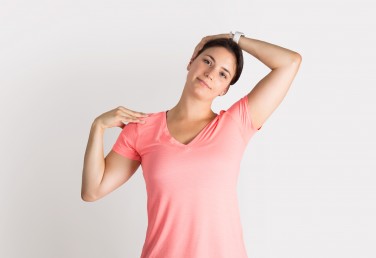
The neck is a central portal and superhighway for our entire nervous system, explains David Reavy, PT, owner of React Physical Therapy in Chicago, IL. “Lack of moving during sleep is a big reason the neck becomes tight,” he says. “To add insult to injury, those who have a desk job and who are sitting for most of the day are constantly pulled forward, so the neck and back are slouched for hours at a time.”
Sit with a straight back and place right hand on right shoulder. Place left hand on right side of head and tilt head to the left, using just bodyweight (not pulling). Hold for 10 seconds then switch sides.
Alternate: Chin Tucks
Sit up straight with back in neutral and tuck chin into chest, like you are trying to give yourself a double chin. Hold for three seconds. Repeat 10 times. For extra pressure, place two fingers on chin when you tuck.

If your shoulders are in a poor position (typically upward rotated, anteriorly tilted), then they will become tight. “You hunch because your scapula won’t fully go in the other direction, and you end up losing full range of motion,” Reavy says.
Stand tall and squeeze shoulder blades together as hard as you can. Hold for three seconds then release. Repeat 12 times.
Stand in doorway. Bend right elbow 90 degrees (palm facing front, fingers towards the sky) and place forearm on outside of doorway. Step forward with left foot and lean forward until you feel a stretch in your pec. Hold for 10 seconds then switch arms.
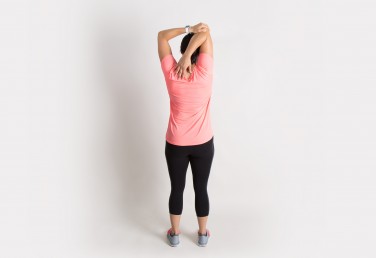
A main reason triceps tend to feel tight is because of muscle imbalance, says Ben Wegman, trainer at The Fhitting Room in New York City. They’re generally weaker than the biceps, the muscle opposite them. Since triceps are worked less often in day-to-day activity, they'll feel tighter when isolated and activated in exercise, he explains.
Reach right arm over your head, bend at the elbow, and place left hand on the front of the right elbow. Gently pull right elbow back and down until you feel tension. Hold for 10 seconds. Release and repeat on the opposite side.
Reach your right arm across body at about shoulder level. Place your left wrist on outside of the right elbow and pull your right arm gently toward body. Stop when you feel a stretch in the right triceps and hold for 10 seconds. Release and repeat on the opposite side.
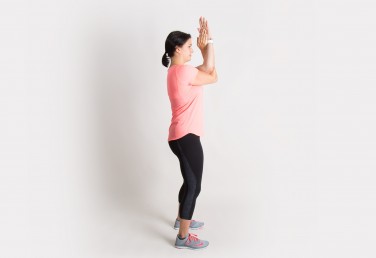
Your forearms are engaged during daily activities like carrying a purse, gym bag, or groceries; typing on a computer; or using a cell phone. “We often don't think to stretch our forearms, but it's a good idea to do so to keep our wrists healthy and to use our arms efficiently,” McGee says.
Spread arms out to sides. Bend elbows and cross right arm in front of left in front of your chest. Then wrap right wrist behind left, so arms are wrapped twice, palms touching one another. (If that's too hard, press backs of hands together.) Hold for 10 seconds. Release and switch arms.
Get down on all fours, hands stacked under shoulders, hips stacked directly over knees. Turn one hand at a time so wrists are facing forward, fingers facing back towards knees. Hold for 30 seconds.
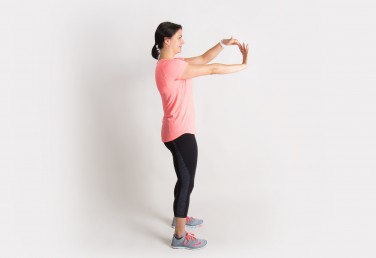
If you’re hoping to lift heavier weights at the gym, it’s necessary that you build grip strength. Working on grip strength helps strengthen your forearms, which allows you to build more muscle overall, but it also affects the wrists, potentially causing tightness, Wegman explains.
Reach right hand out in front of you, parallel to the ground. Flex wrists back, fingers pointing towards ceiling, palms facing forward. Spread fingers wide and gently pull back on thumb with left hand. Hold for a few seconds. Move on to pointer finger, then middle finger, and so on, holding each finger for a few seconds. Release and repeat with the opposite hand.
Start with palms together in front of chest just below chin. Slowly lower your hands toward your waistline, keeping hands close to your stomach and palms together, until you feel a mild stretch in your wrists and forearms. Hold for 15 to 30 seconds. Repeat 2 to 4 times.

Our backs control so much of our movement and are very delicate. “Our lats, glutes, paraspinals, and abs are all connected to our backs, which is why we need to keep our back strong and in use,” Reavy says. “But because almost every movement affects the back, it's easy for people to hurt it with the slightest movement.”
Stand with feet hip-width apart, hands on hips, and slowly lean backward until you feel a stretch in your lower back. Hold for 3 seconds. Repeat 12 times.
Lie on your back, knees bent with feet flat on the floor, hip-width apart. Keep back flat and let both knees fall to right side. Hold for 10 seconds then repeat on opposite side.

“Our abs and obliques are our endurance muscles for every activity we do,” McGee explains. “We use our core for everything from lifting and squatting to picking things up to classes like yoga and Pilates, where we use our own bodyweight to support ourselves.”
Lie facedown, bend elbows, and place palms on floor next to chest. Pointing toes, press tops of feet into floor and press chest up as you straighten your arms and lift thighs and knees off floor. Keep chest open and look up.
Lie faceup, knees bent with feet flat on floor, hip-distance apart. With glutes engaged, push through heels and lift hips into air, resting on shoulders. Interlace hands underneath hips and puff your chest to your chin to stretch open entire abdominal region and sides of waist. Hold for 30 seconds.
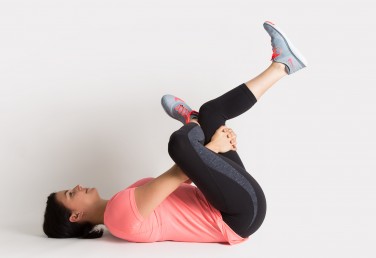
“Glutes are the heaviest part of your body and a prime mover complex that helps you walk, run, and jump more efficiently,” explains Andia Winslow, trainer at Mile High Run Club in New York City. And since they're used so frequently, they can get tight easily.
Try: Figure 4 Stretch
Lie faceup and bend both knees so feet are resting flat on floor in front of you, hip-distance apart. Draw right leg off ground and cross it over the left, so right ankle is resting against left knee. Reach hands through and grab back of left thigh, lift, and pull left leg in towards chest. Hold for 10 seconds then switch legs.
Sit on floor with both legs fully extended in front of you. Lift right leg, bend knee, and cross it over left leg, placing foot on the ground. Hug right leg into your chest. Hold for 10 seconds then switch legs.
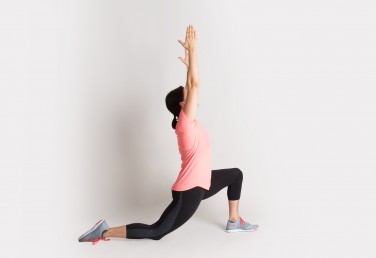
These muscles help your legs move, so you use them more than you could imagine. Whether you’re walking, running, or cycling, your hip flexors are involved. And when you’re at a desk all day, you’re making them even tighter. “When we sit, the hip flexors are dormant and shortened, so they tend to get tight, cramp, and pull on our lower backs,” explains McGee.
Start on all fours. Step right foot forward between hands and lengthen the left leg back, placing left shin and top of left foot on the floor. Let hips fall towards the floor as you lunge into front knee and bend back, opening up through the chest with arms extended overhead. Hold for 10 seconds then switch sides.
Stand tall and lift right leg behind you, bending at the knee. Catch top of the foot with right hand. Keeping left leg straight, slowly raise right foot behind you and lean slightly forward. Left arm lifts to ceiling in front of you. Balance for 10 seconds then switch legs.

”If you’re not using the posterior chain properly (glutes, hamstrings, etc.), the quads take on the extra work,” Winslow explains, “and because most folks don't stretch properly, this leads to undue tightness and soreness.” Not warming up properly and fatigue can also cause the quadriceps to cramp up.
Stand tall and lift right leg behind you, bending at the knee. Catch right foot with right hand. Keeping right knee pointing down and both knees close, pull right heel into glutes. Hold for 10 seconds then switch legs. Hold onto a chair or couch with unused hand if you have trouble balancing.
Lie facedown, legs stretched out behind you. Bend right knee and grab right foot with right hand, pulling heel towards glutes. Keep right knee parallel to ground, both knees together. Hold for 10 seconds then switch legs.
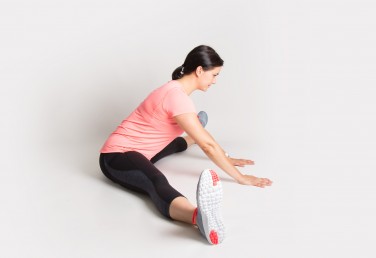
“Your inner thighs might not be the most powerful muscle group, but that doesn't mean they can't get tight,” says Liz Barnet, certified trainer at Uplift Studios and SLT in New York City. “Whether from underutilization, lack of functional movement, or just sitting in a chair with your legs crossed, your inner thighs can get just as tight as your more active muscle groups.” And you don’t want to ignore them as that can create muscle imbalances.
Sit with legs extended straight out in front. Separate them to respective sides as wide as you can, sitting equally on both sit bones. Flex toes up towards ceiling, sit up straight, and begin walking hands out in front of you as far as possible. Make sure to keep your back straight—that's more important than how far you go. Hold for 30 seconds. (If you can’t touch the floor, grab a yoga block or just touch with fingertips.)
Kneel on a cushioned surface like a yoga mat or rug with hands flat on the floor in front of you. Start to separate knees apart, keeping shins and tops of feet pressing down into ground. If it's too intense, support more of your body weight with your hands and upper body. Hold for 30 seconds.
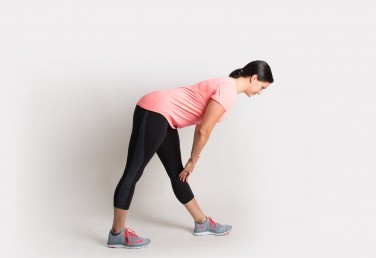
“The hamstrings are very easy to pull and/or injure,” Wegman says. “This can be due to many factors, including not warming up before exercising, tight quadriceps pulling your pelvis forward and tightening the hamstrings, and weak glute muscles.” Your glutes work in tandem with your hamstrings and can overload your hamstrings if they're weak.
Stand with feet together. Step your right foot back about two feet behind left, staggered, and bend forward from hip joint, keeping your back and both legs straight. Either keep hands on hips or place gently on shin. Hold for 30 seconds then switch sides.
Stand with feet hip-width apart. Interlace your hands behind your head. With a slight bend in knees, hinge at hips and bend forward, keeping back flat. Hold for 10 seconds then release. Repeat two more times. Stop if you feel your back start to round.
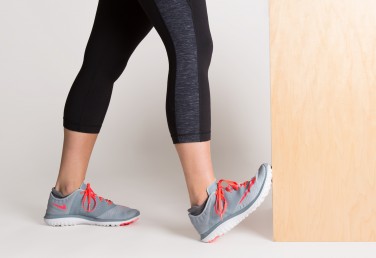
“Your calf muscles tend to be one of the most worked muscle groups due to the constant nature of being on your feet all the time—walking, running, and standing,” Wegman says. Lots of factors can cause them to cramp, including insufficient stretching, fatigue, poor blood circulation in the legs, dehydration, and deficiencies in vitamins, such as magnesium, potassium, and calcium. Ever experience a charley horse? That and other spasms in the calf muscles are caused by these vitamin deficiencies as well as dehydration.
Stand a little less than arm's distance from wall. Keeping feet parallel, step right foot forward until toes touch wall in front of you. Bend your right knee and lean forward to place hands on wall while keeping back leg straight and pressing heel into the ground. Hold for 30 seconds and switch legs.
Start on all fours, hands stacked under shoulders, hips stacked directly over knees. Walk hands forward slightly on the floor until arms are straight. Spread your fingers apart to allow for a broad base of support. Engage abs and push hips up towards ceiling, coming onto your feet. Keep your heels on the ground and gently try and straighten your knees. Hold for 30 seconds.

While the Achilles is a small tendon, it’s not too fragile. “The issue becomes that we overuse our soleus (or deep calf muscle) and plantar fascia, putting the Achilles in a constant stretch, which makes our gastrocnemius or upper calf muscles and our glutes inefficient,” explains Reavy. “Muscles need to lengthen and then shorten with every movement, and in this case the muscle is so tight there is a constant pull on the Achilles, which isn’t good.”
Standing with feet hip-width apart, step right foot forward about two feet and plant foot firmly on ground. Lift toes of right foot toward ceiling and dig heel into ground.
Place tennis ball or lacrosse ball under right foot. Apply as much body weight as comfortable as you roll ball under bottom of foot. Roll for 30 seconds then switch feet.
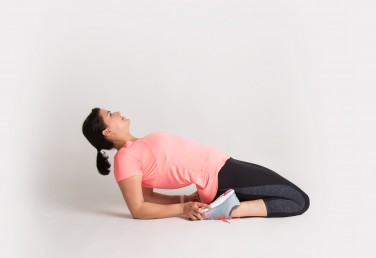
Who knew such a small body part would have 20 muscles? “It's easy to neglect our feet and strain them when we wear shoes that aren't supportive, or overuse them in training, especially to compensate for weaker muscles,” McGee says.
Kneel on floor then sit back onto legs. Open legs wide, pushing feet out to the sides and sit between heels, leaning back as far as possible. Hold for 30 seconds. If you don’t have the range of motion to lean back all the way, stay upright, keeping back straight. And place a mat or towel above calves if it’s too painful.
Start in plank position. Keeping abs engaged, let hips drop towards floor as your chest opens up through your arms, and slowly place tops of each foot on floor. Press firmly into all ten toes and hold for 30 seconds.
Special thanks to our model, Liz Barnet, certified trainer at Uplift Studios and SLT in New York City.
Original article and pictures take greatist.com site
Комментариев нет:
Отправить комментарий